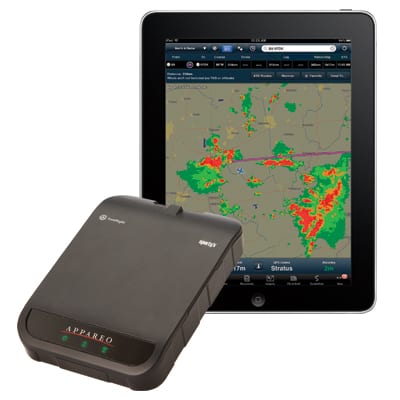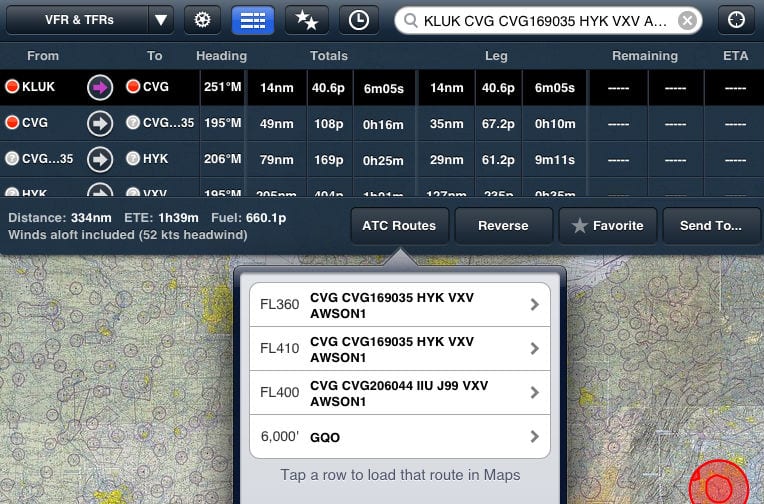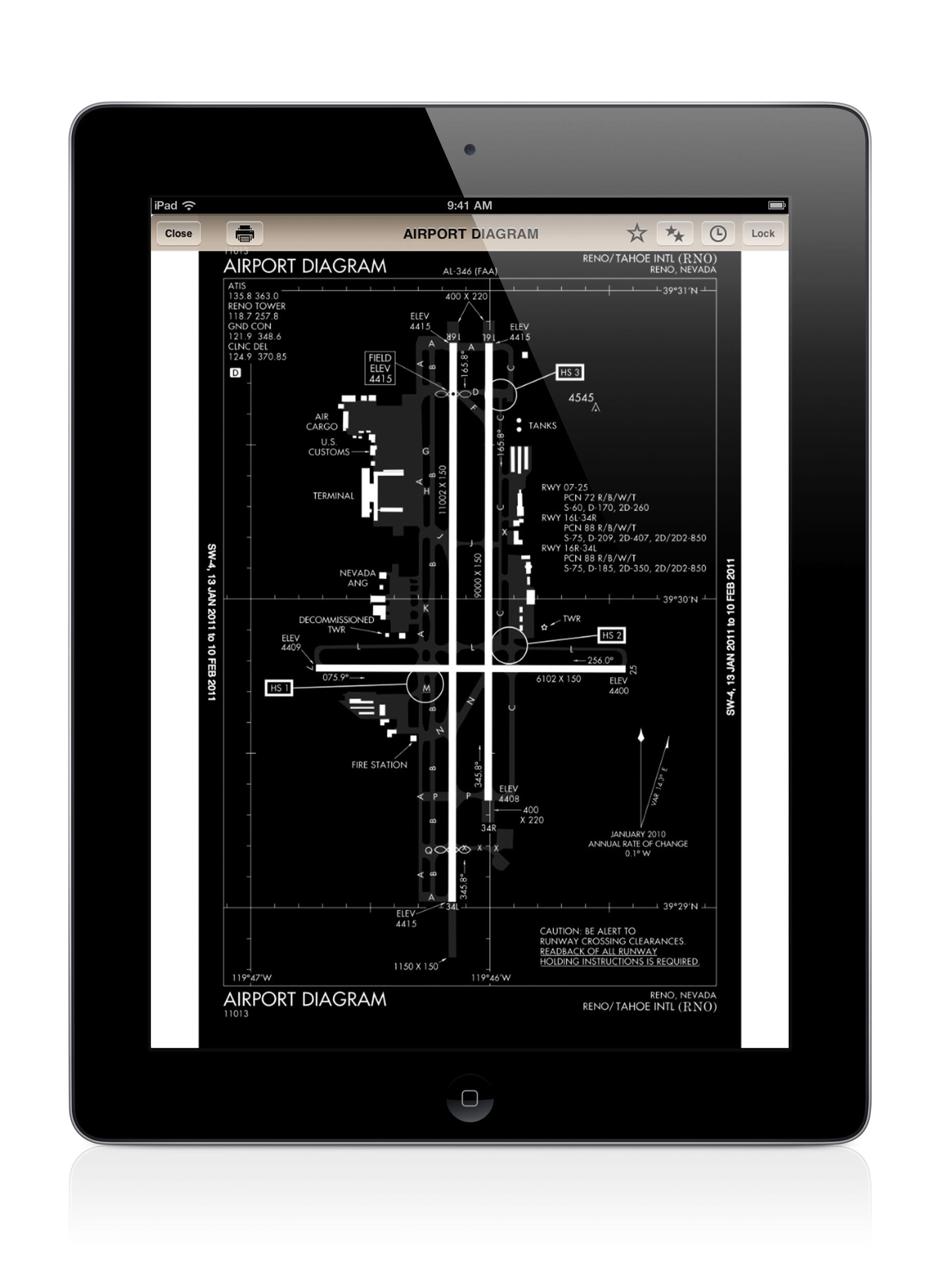Sporty’s introduces weather receiver for ForeFlight
Many iPad pilots have been asking for in-flight weather on their favorite apps, but the options so far have been pretty scarce. Until now, weather receivers have required either a lot of wires or a monthly XM Weather subscription.
Today saw the introduction of an impressive new option, and it is both portable and subscription-free. At Sun ‘n Fun, Sporty’s launched the Stratus, a portable weather receiver specifically made for the iPad. It combines an ADS-B and GPS receiver into a single unit that wirelessly streams NEXRAD radar, text weather, TFRs and aircraft position to the popular ForeFlight Mobile app for iOS devices. The device retails for $799 and does not require a monthly weather subscription.
This is a totally portable device, so it requires no installation. Features include:
- Built-in eight hour battery
- Internal WAAS GPS receiver
- Internal ADS-B antenna
- WiFi connection to the iPad
- Single button operation
The unit receives the full suite of available ADS-B weather products: NEXRAD radar, METARs, TAFs, SIGMETs, AIRMETs, PIREPs, TFRs, and winds aloft. ADS-B is a ground-based network, so pilots should be sure to check the coverage map for their local area. The entire US should be covered by ADS-B by late 2013.
Stratus also includes a built-in WAAS GPS receiver that provides high-quality position information, so ForeFlight’s map page becomes a powerful navigator. Pilots can overlay flight plans on VFR sectional and IFR enroute charts, and geo-referenced approach plates are an option. The moving map page can be configured to show a variety of information, from flight plan route to groundspeed to ETA.
And here’s a convenient feature: the WiFi connection allows multiple iPads to connect to Stratus. This should be valuable for two-pilot crews to view weather on separate iPads.
For more information on Stratus, or to order, visit sportys.com/stratus. The unit is expected to ship April 23.













I find it strange that this unit was developed with a WiFi interface rather than Bluetooth, especially when you consider that WiFi uses 10 to 100 times more power than Bluetooth
Marcus, WiFi allows for more data transfer, and it also allows multiple devices to connect at once–an iPad and iPhone or multiple iPads in a two-pilot cockpit.
I thought ADSo-B also gave traffic? and weather.
Traffic would be nice! & worth it!
Ron and Dave–ADS-B does include traffic, but it works quite differently than the weather. In simple terms, if you are not broadcasting ADS-B Out (with a panel-installed transponder upgraded), you will not reliably get traffic in. So while traffic could be displayed, it’s only a very small slice of the actual traffic picture–and that’s not safe. As we get closer to 2020 and more airplanes are equipped with ADS-B Out, traffic will become a viable option.
Thanks for this post! Since ADS-B is a ground based signal, I understand that you have to be at a specific AGL to be able to “see” the signal. I have enjoyed having XM from before take-off and there have been times when it was useful to check area weather before a launch. Am I correct that this won’t be an option with ADS-B?
You’re correct, Tim. Unless there is an ADS-B station at the airport (which does happen), you won’t get ADS-B weather on the ground. However, you will get it by 500 ft. AGL in many places. In addition, if you’re using an iPad or iPhone, you can get internet-based weather either via the FBO’s WiFi or your 3G/4G cell connection. So you can still get good weather data on the ground.
For those of us with Garmin mode S transponders, the easiest way to augment the soon to be obsolite TIS-B traffic would be to upgrade the transponder to the ES version and use a device like yours for the traffic display. Do you have any plans for an early implementation of traffic display to someone who has the ADS-B out capability already in the airplane?
Michael, it’s something we’re seriously considering. No firm plans, but it’s on the list. We’ll keep you posted.
Thanks for the prompt reply. Just as a data point, given your price point, the moment that option becomes available, I’ll update the transponder to the ES version and buy your unit. For now, I’m happy with the XM weather and music I get on my Garmin 696 and don’t see the benefit of change.
How does this unit compare to the skyradar product? I know skyradar does not interface with forFlight but it does with Wing X Pro. I have the skyradar, is there a reason to consider upgrading to the Stratus?
Eugene, the biggest difference (in addition to the ForeFlight interface you mentioned) is that Stratus is totally wireless. Whereas the SkyRadar has an external GPS antenna and needs a power plug, Stratus is an all-in-one box.
Eugene,
Skyradar sends a standard ADS-B data stream to WingX Pro7. As far as I know the Stratus box uses a proprietary interface between it and FF (someone please correct me if I am wrong here). If this is correct, then FF have the advantage that they don’t have to write the ADS-B decoding software (which is non-trivial, I know, I wrote the WingX Pro7 ADS-B code). The advantage WingX Pro7 has is that it works great with the Skyradar receiver, NavWorx says it works with their ADS-B receiver, and it’ll work with the new ADS-B receivers planned for later this year giving you the most flexibility. Skyradar also offer a dual-channel receiver – WingX Pro7 uses this receiver to display 1090ES traffic and we’ll expand this to include 978MHz traffic soon.
One other interesting limitation of the Stratus receiver is that you can/will damage (and/or shorten the life of) the battery if you leave the receiver in the aircraft. Again, please correct me if I am wrong here, but the maximum storage temperature is only 113F (Stratus specifications). The plane’s ‘dash’ can apparently almost get to 200F. According to Wikipedia: “Lithium-ion batteries can rupture, ignite, or explode when exposed to high temperature.” I’m not trying to spread FUD here, but the “no wires” advantage does come with its negatives that are worth noting.
Hilton
Wouldn’t the same battery limitations apply to the iPad? Has there been any reports of igniting or exploding? Does the Stratus even need to be stored on the dash? I checked the environmental requirements for the iPad2 on Apple’s website.
“Nonoperating temperature: -4° to 113° F (-20° to 45° C)”
So as long as you treat the Stratus the same as your iPad, you’re in good shape.
I was under the impression that a dual band Skyradar is a premium option that carries a premium price. I also understand that the 1090 band doesn’t provide FIS information for weather and that the 1090 TIS information is only intended for use if you have ADS-B out.
I had to google FUD.
Chris,
You are correct wrt battery limitations. if it were not for the battery issues my SOP would be to take my iPad with me and leave the receiver on the dash or in the plane. You raise a good point; i.e. on hot days, don’t leave your iPad in the plane or car.
The single channel Skyradar receiver supports 978MHz – that includes the NEXRAD, METARs etc and traffic. They also have a (more expensive) dual-channel receiver that includes the 978MHz piece and an additional 1090 MHz receiver. This 1090 MHz channel gives WingX Pro7 additional traffic data. WingX Pro7 sees the data from both channels so with a dual-channel receiver WingX Pro7 will see both FIS-B and TIS-B.
Thanks,
Hilton
Believe it or not, flying a Boeing 767 for a major airline, you would think that we would have access to up to the minute weather, pireps, etc., we only get what the dispatcher has time to send up, and then, only in text format. On the advice of a helicopter pilot, I purchased the Stratus device. While I was able to receive limited ADSB data, I was completely unable to lock onto any GPS signal whatsoever. I attempted numerous locations within the cockpit, window heat on, window heat off, and absolutely nothing. Incredibly, the internal GPS within the iPad gave me intermittent GPS info, but not reliable at all. In closing, if you fly an airplane with a thick, heated windshield, this device most likely will not work.
The GPS is affected by the thick glass more than the heated part. Have you tried it on a side window? We’ve had great success in jets with Stratus up in a side window, using the suction cup mount if needed: http://www.sportys.com/PilotShop/product/17456
When old this be available for Africa or southern Africa (stratus with foreflight or any mapping app for the I pad ?
Not anytime soon, Deon. Right now ADS-B weather is only available in the US.
does foreflight have geo referenced approach plates and charts for southern africa?
No.